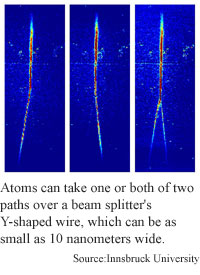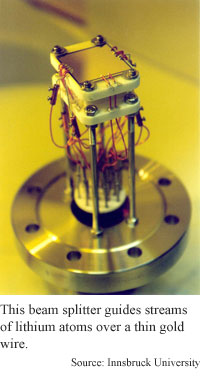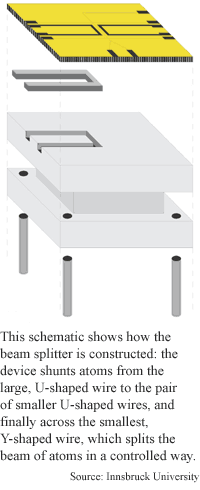
Switch channels atom beams
By Kimberly Patch, Technology Research NewsMaking relatively small numbers of atoms flow over a tiny wire is considerably trickier than, say, guiding water through a hose. There are some similarities, however.
A group of European researchers has built a tiny beam splitter for guiding atoms that is essentially a forked wire that lures a batch of atoms along either fork or coaxes half to go one way and half the other. "The idea for the beam splitter is simple -- build a tube where the atoms can go and make the tube split from one into two," Jörg Schmiedmayer, a professor of experimental physics at the University of Heidelberg.
The wire is 10 microns in diameter, or about twice the size of a red blood cell, and will likely scale down three orders of magnitude to 10 nanometers, he said.
The beam splitter is a step toward controlling small batches of atoms at a scale that could be useful for studying their quantum behavior. It could also eventually be used in miniaturized matter-wave optics devices like rotation or inertial sensors that measure gravity and rotation, said Schmiedmayer.
The atoms need a bit more guidance than the water in a garden hose, however. "The atoms are guided and trapped using magnetic potentials [of wires] combined with external bias fields," Schmiedmayer said.
The researchers made the beam splitter by adding a 2.5-microns layer of gold to a gallium arsenide substrate, then etching grooves into the gold to define several sets of tiny wires.
The beam splitter is made up of the 10-micron wires that guide the atoms, a pair of U-shaped 200-micron wires that are used to load atoms into the smaller wire, and a 1-millimeter-thick U-shaped wire underneath the chip that feeds atoms to the 200-micron wires.
To use the device, the researchers compress about one billion lithium atoms using a laser and let them accumulate in a reflection magnetoresistance trap -- the large, U-shaped wire underneath the chip. When the laser is turned off the atoms remain in the wire, held by a current running through the wire that generates an electromagnetic field. They then compress the atoms again and transfer them to the smaller pair of U-shaped wires on top of the chip by diminishing the current running through the bottom wire and at the same time increasing the current generating the smaller trap.
When the atoms are fed from the pair of U-shaped wires to the Y-shaped beam splitter, they are guided through a specific fork because the atoms are more likely to traverse the fork that carries more electrical current. When both forks contain a similar amount of current, they attract similar numbers of atoms.
"The atoms are guided in a magnetic tube formed by the current in the wires and external bias field. If the current flows through one arm, the atoms follow. If the current flows in both arms, then the atoms have at the splitting point two possibilities... and they can choose," said Schmiedmayer.
In general, atom guiding and atom chips are an exciting development in atomic physics, said Wolfgang Ketterle, a physics professor at the Massachusetts Institute of Technology. "In the future, they may advance... precision measurement and lead to matter wave devices."
Atom guiding devices like beam splitters "deliver atoms to experiments," Ketterle said. "Guided atoms don't fall down like free atoms and can therefore be used for longer and therefore more precise measurements. For interferometric applications you need atoms which move [rather than] atoms which are at a rest."
Major challenges leading to these applications, however, are still ahead, said Ketterle. Today's atom beam splitters are like T's in a garden hose, guiding atoms through space, but not discriminating in terms of the atom's wave properties, he said. "The biggest challenge and most important goal is to do things coherently and to control the phase of the propagating atoms,” said Ketterle.
In coherent beams, whether light or matter, waves are the same length and move in step, or phase. Coherent wavelengths are more useful in electronics devices than a beam of waves that differ slightly from each other. Lasers, for instance, produce coherent light.
Schmiedmayer and his colleagues are currently working on testing their beam splitter to see if they can produce coherent beams of atoms. According to their calculations, this type of beam splitter should produce coherent beams at least in some circumstances, Schmiedmayer said.
The experiment to test the beam splitter will include "building an interferometer out of two beam splitters, one to split the atom wave, the other to recombine it," he said.
The first possible applications for the beam splitter are atom interferometers and studies of quantum systems on atom chips. It is also potentially useful as sensors in microelectromechanical systems (MEMS) and may even scale down to the nano electromechanical systems (NEMS) size.
"In general a beam splitter like the one demonstrated in our work will be a central element in miniaturized matter-wave optics. These could lead to rotation or inertial sensors or other matter-wave devices," Schmiedmayer said.
It should be possible to tell whether this type of technology will be useful for quantum information processing sometime in the next two to five years, he said.
Schmiedmayer's research colleagues were Donatella Cassettari of the University of Innsbruck, Björn Hessmo of the University of Innsbruck and Uppsala University, Sweden, Ron Folman of the University of Innsbruck and the University of Heidelberg, and Thomas Maier of the University of Technology in Vienna, Austria. They published the research in the December 25, 2000 issue of Physical Review Letters. The research was funded by the Austrian Science Foundation and the European Union.
Timeline: 2-5 years
Funding: Government
TRN Categories: Integrated Circuits; Optical Computing, Optoelectronics and Photonics
Story Type: News
Related Elements: Photo 1, Photo 2; Technical paper, "Beam Splitter for Guided Adams," Physical Review Letters, December 25, 2000.
Advertisements:
January 31, 2001
Page One
Store globally, access locally
Ordinary light could drive quantum computers
Color deepens data storage
Motor goes all the way around
Switch channels atom beams



News:
Research News Roundup
Research Watch blog
Features:
View from the High Ground Q&A
How It Works
RSS Feeds:
News
Ad links:
Buy an ad link
| Advertisements:
|
 |
Ad links: Clear History
Buy an ad link
|
TRN
Newswire and Headline Feeds for Web sites
|
© Copyright Technology Research News, LLC 2000-2006. All rights reserved.